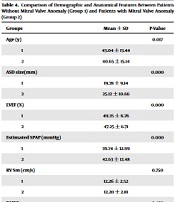Prevalence and Hemodynamic Consequences of Mitral Valve Abnormalities in Atrial Septal Defect

Highlights
- Based on the mechanism of prolapse, isolated MVP is divided into functional and anatomical groups. Characteristics of anatomical MVP are chorda elongation and leaflet elongation (View Highlight)
- volume overload in the right side of the heart, RV dilation, left-side shift of the inter-ventricular septum, and finally, the inward shift of the LV papillary muscle leads to shortening of the inter-papillary distance and redundant chordae tendinea. These are the geometric mechanisms of MVP in ASD patients, which is expected to improve after ASD closure (View Highlight)
- Hypoplasia of the PMVL is an abnormal condition mainly diagnosed in childhood with symptoms of mitral regurgitation, even though in the milder degrees of valvular regurgitation, patients remain asymptomatic until late adulthood. (View Highlight)
- Hypoplastic PMVL with or without prolaptic AMVL can be seen solely or associated with other cardiac conditions. Secundum ASD is the most common congenital defect associated with hypoplastic PMVL in the literature. When there is significant mitral regurgitation in these patients, transcatheter methods for ASD closure are not suitable, and patients need mitral valve repair or replacement in combination with surgical ASD closure (View Highlight)
- left to right shunt in the atrial level that alleviated the hemodynamic effect of mitral regurgitation, and patients became symptomatic later during adulthood. (View Highlight)
- Lutembacher described atrial septal defect and simultaneous rheumatic mitral valve disease in 1916 (View Highlight)
- Clefts of the mitral valve leaflet are an integral component of ostium primum ASD. (View Highlight)
